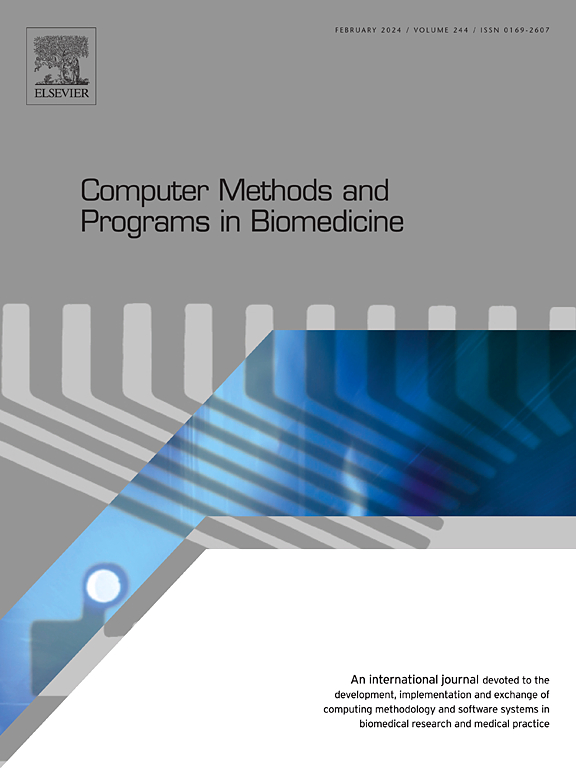DC-MSSFF Net: Dule-channel multi-scale spatial-spectral feature fusion network for cholangiocarcinoma pathology high-resolution hyperspectral image segmentation
IF 4.9
2区 医学
Q1 COMPUTER SCIENCE, INTERDISCIPLINARY APPLICATIONS
引用次数: 0
Abstract
Background and Objective:
High-precision segmentation of pathological images is a challenging task in the field of medical image processing. Hyperspectral microscopic imaging offers a distinct advantage in histopathological image segmentation due to its abundance of spectral and spatial data.
Methods:
Here, a Dule-Channel Multi-Scale Spatial-Spectral Feature Fusion Network (DC-MSSFF Net) is proposed for semantic segmentation of cholangiocarcinoma hyperspectral images (HSI). The DC-MSSFF Net is composed of two parallel channels, graph-within-graph (GwG) and multi-scale CNN. The GwG can greatly reduce the computational burden while establishing the spatial context relationship of the HSI image. The multi-scale CNN channel is able to fine-tune the segmented edges of the HSI images at the pixel-level based on hyperspectral information in the depth dimension. Afterwards, the segmentation results are achieved by fusing the features from the two channels. Furthermore, an ensemble-based framework is applied to further improve the performance of the model.
Results:
The image segmentation evaluation indexes such as dice similarity coefficient (Dice) of the Cholangiocarcinoma HSI data can reach 70.47, which is much higher than the SOTA method and RGB-based image segmentation methods.
Conclusion:
The superior performance of the DC-MSSFF network pioneers the inductive learning task of deep frameworks for semantic segmentation of high-resolution hyperspectral image (HR-HSI).
DC-MSSFF网络:用于胆管癌病理高分辨率高光谱图像分割的双通道多尺度空间光谱特征融合网络
背景与目的:病理图像的高精度分割是医学图像处理领域的一项具有挑战性的任务。高光谱显微成像由于其丰富的光谱和空间数据,在组织病理学图像分割中具有明显的优势。方法:提出了一种双通道多尺度空间-光谱特征融合网络(DC-MSSFF Net),用于胆管癌高光谱图像的语义分割。DC-MSSFF网络由图中图(GwG)和多尺度CNN两个并行通道组成。GwG在建立HSI图像的空间上下文关系时,可以大大减少计算量。多尺度CNN通道能够基于深度维度的高光谱信息在像素级微调HSI图像的分割边缘。然后,将两个通道的特征融合得到分割结果。此外,采用基于集成的框架进一步提高了模型的性能。结果:胆管癌HSI数据的骰子相似系数(dice)等图像分割评价指标可达70.47,远高于SOTA方法和基于rgb的图像分割方法。结论:DC-MSSFF网络的优越性能为高分辨率高光谱图像(HR-HSI)语义分割深度框架的归纳学习任务开辟了道路。
本文章由计算机程序翻译,如有差异,请以英文原文为准。
求助全文
约1分钟内获得全文
求助全文
来源期刊

Computer methods and programs in biomedicine
工程技术-工程:生物医学
CiteScore
12.30
自引率
6.60%
发文量
601
审稿时长
135 days
期刊介绍:
To encourage the development of formal computing methods, and their application in biomedical research and medical practice, by illustration of fundamental principles in biomedical informatics research; to stimulate basic research into application software design; to report the state of research of biomedical information processing projects; to report new computer methodologies applied in biomedical areas; the eventual distribution of demonstrable software to avoid duplication of effort; to provide a forum for discussion and improvement of existing software; to optimize contact between national organizations and regional user groups by promoting an international exchange of information on formal methods, standards and software in biomedicine.
Computer Methods and Programs in Biomedicine covers computing methodology and software systems derived from computing science for implementation in all aspects of biomedical research and medical practice. It is designed to serve: biochemists; biologists; geneticists; immunologists; neuroscientists; pharmacologists; toxicologists; clinicians; epidemiologists; psychiatrists; psychologists; cardiologists; chemists; (radio)physicists; computer scientists; programmers and systems analysts; biomedical, clinical, electrical and other engineers; teachers of medical informatics and users of educational software.
 求助内容:
求助内容: 应助结果提醒方式:
应助结果提醒方式:


